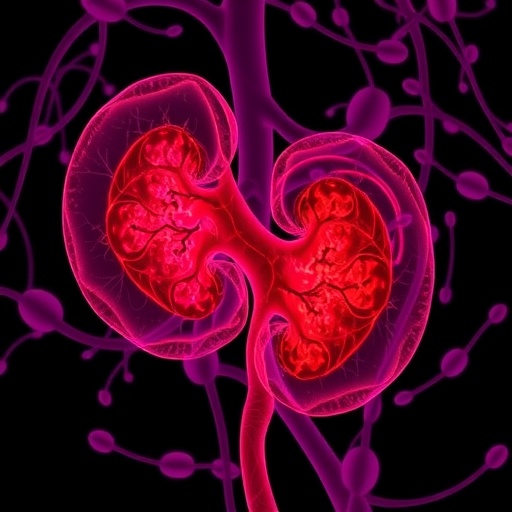Recent research has unveiled crucial insights into the interplay between microRNA and diabetic nephropathy, a condition that disproportionally affects individuals with diabetes. A paper by Lv, Zhang, and Luo presents a compelling investigation into the role of miR-302a-3p in this context, offering a new avenue for understanding the underlying mechanisms of inflammation and kidney dysfunction associated with diabetes. This emerging research sheds light on miR-302a-3p’s functions, position within cellular pathways, and potential as a therapeutic target.
Diabetic nephropathy is characterized by a spectrum of kidney damage, often culminating in end-stage renal disease. As diabetes prevalence continues to rise globally, understanding the biological underpinnings of nephropathy becomes increasingly critical. In this regard, the study highlights a significant dysregulation of miR-302a-3p in the kidney tissues of diabetic models. The microRNA, an essential regulator of gene expression, appears to play a pivotal role in modulating inflammatory responses, which is a hallmark of diabetic nephropathy.
MicroRNAs, such as miR-302a-3p, are small, non-coding RNA molecules that post-transcriptionally regulate gene expression, influencing various biological processes. Their dysregulation has been implicated in a plethora of diseases, including cancer and metabolic disorders. The research conducted by the authors fractures traditional thinking around the singular role of metabolic dysregulation in kidney disease, positioning inflammatory pathways to the forefront of diabetic nephropathy research.
The authors employed a combination of in vitro and in vivo methodologies, allowing them to validate their findings in a real-world context. They observed that miR-302a-3p levels were significantly reduced in diabetic nephropathy models, suggesting a potential protective role for this microRNA. The decrease in miR-302a-3p coincided with heightened levels of pro-inflammatory cytokines, which are known to exacerbate kidney injury. This correlation offers a tantalizing glimpse into the potential mechanistic pathways that drive diabetic nephropathy.
Moreover, the research asserts the significance of the balance between pro- and anti-inflammatory agents in the progression of kidney damage. The role of miR-302a-3p as an anti-inflammatory molecule may make it a critical regulator in preserving kidney function in individuals with diabetes. By mitigating inflammation, the restoration of miR-302a-3p levels might present a new therapeutic strategy for combating diabetic nephropathy and related complications.
Importantly, the findings resonate well with existing literature that links inflammatory processes with renal injury. The study expands upon previous work, suggesting that therapeutic modulation of miR-302a-3p could pave the way for novel interventions aimed at attenuating the deleterious effects of inflammation. This could ultimately contribute to improved patient outcomes and offer a paradigm shift in managing chronic kidney diseases associated with diabetes.
As researchers continue to explore the complex relationship between various microRNAs and chronic diseases, miR-302a-3p stands out as a promising candidate for further investigation. Understanding its precise role in cellular signaling pathways will be crucial for harnessing its potential as a therapeutic target. Additionally, future studies are likely to dissect its interactions with other regulatory molecules, forging a comprehensive understanding of the molecular landscape of diabetic nephropathy.
The implications of this research extend beyond basic science; they carry significant translational potential. By elucidating the biological significance of miR-302a-3p, the authors prompt a reconsideration of current treatment modalities that focus predominantly on glucose control in diabetes. Strategies that also target microRNAs could yield synergistic effects, enhancing therapeutic efficacy and improving patient quality of life.
The dialogue surrounding microRNAs like miR-302a-3p is just beginning. As this area of research evolves, the potential for developing miRNA-based therapies will attract attention from biopharmaceutical companies, academic researchers, and healthcare providers alike. By strategically leveraging the regulatory capacities of microRNAs, it may be possible to create robust treatments for diabetic nephropathy that not only slow disease progression but also promote kidney health.
In conclusion, the investigation by Lv, Zhang, and Luo marks a significant step forward in our understanding of diabetic nephropathy. By focusing on miR-302a-3p, the researchers provide a new lens through which to view inflammatory processes and their impact on kidney health. As future research builds upon these foundational findings, the hope is that new strategies will emerge to mitigate the burden of diabetic nephropathy and enhance the lives of those affected by this challenging condition.
The study’s meticulous approach and compelling findings underscore the essential role of microRNAs in the pathophysiology of chronic diseases. As researchers continue to clarify how these molecular players operate within the intricate network of cellular signaling, the promise of targeted interventions for diabetic nephropathy grows ever clearer. This research not only highlights the need for innovative treatments but also nourishes the notion that understanding the body’s intricate molecular machinery is essential for combating complex health challenges such as diabetes.
The exploration of miR-302a-3p in the context of diabetic nephropathy thus emerges as a noteworthy contribution to the fields of endocrinology and nephrology. It challenges existing paradigms and suggests that future therapeutic avenues must consider the nuanced roles of inflammatory regulators in metabolic diseases. The journey toward understanding diabetic nephropathy has taken a significant turn, paving the way for clinical advances that could transform patient care.
By articulating these insights and implications, the study ultimately serves as a clarion call for the integration of microRNA research into standard clinical practice. Continued exploration of miR-302a-3p and its relatives may enable healthcare professionals to devise more holistic and effective treatment paradigms for diabetes-related complications. As we stand at the precipice of new discoveries, the urgency for continued research in this domain cannot be overstated.
Subject of Research: Dysregulation of microRNA in diabetic nephropathy
Article Title: Dysregulation of miR-302a-3p in diabetic nephropathy and its role in inflammatory response
Article References:
Lv, L., Zhang, X. & Luo, G. Dysregulation of miR-302a-3p in diabetic nephropathy and its role in inflammatory response.
BMC Endocr Disord 25, 233 (2025). https://doi.org/10.1186/s12902-025-02051-7
Image Credits: AI Generated
DOI: 10.1186/s12902-025-02051-7
Keywords: microRNA, diabetic nephropathy, inflammation, miR-302a-3p, therapeutic targets, chronic kidney disease.




